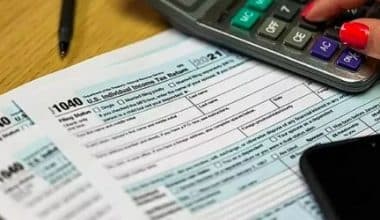Businesses of all sizes must pay and meet federal, state, and local taxes to avoid getting in trouble with the law. However, the kind of taxes your firm is required to pay depends on its location and organizational structure. On the other hand, if you as an individual fail to file and pay your taxes on time and you have a balance due, you will be subject to interest and a late payment penalty. And the IRS has declared the deadline for filing federal income taxes for all taxpayers is April 18, 2023, instead of April 15. This is a result of the District of Columbia’s Emancipation Day holiday. But how do you pay your taxes? This piece focuses on how to pay taxes on self-employment or as an independent contractor as well as where and when (quarterly, yearly) to pay it.
How to Pay Taxes
Nobody likes getting a tax bill in the mail. But, it is important to know your payment choices in case you do owe money for taxes. Below you will learn about how you can pay your taxes and make an informed decision.
#1. Direct pay
Direct pay is an alternative for those who want to avoid paying any costs while making a tax payment. You can use this option to settle your tax due quickly and easily from your bank account, and you’ll get an instant receipt for your transaction. Your payment plan can be set up to 30 days in advance, and you’ll have up to two business days before the payment is due to make any adjustments or cancel it entirely.
#2. Electronic Funds Withdrawal
You can also pay your taxes through Electronic Funds Withdrawal (EFW), although your bank or credit union may charge you a fee. The only way to use this mode of payment is to electronically submit your federal taxes through either tax preparation software, a tax professional, or the IRS’s Free File service. With EFW, you may pay a single or recurring bill electronically from your bank account and set up automatic payments up to a year in advance.
#3. Electronic Federal Tax Payment System
The Electronic Federal Tax Payment System is another option for settling your tax liability with the government (EFTPS). To make a payment through this method, you’ll need your Social Security number (SSN) or Individual Taxpayer Identification Number (ITIN), a personal identification number (PIN), an internet password, and a secure browser. If you’re willing to sign up for this service, you can do it online or over the phone and expect the enrollment process to take up to five days. By using EFTPS, you can set up payments up to a year in advance and get instant confirmation of each transaction.
#4. Credit and Debit Cards
You can pay your taxes online or over the phone with a debit or credit card. The Internal Revenue Service does not assess a price for this service, although third-party suppliers typically do. There is a cost associated with using PayUSAtax, Pay1040, or ACI Payments, Inc. The typical fee for using a debit card is between $2 and $4. Fees for credit card purchases are calculated as a fixed percentage of the total purchase price. A taxpayer may be charged a fee of $19.90 for a credit transaction of $1,000, and a fee of $199 for a credit transaction of $10,000. You can pay your taxes using any of the following methods: Visa, Discover, American Express, Mastercard, STAR, Pulse, NYCE, Accel, PayPal, or PayNearMe.
#5. Cash
You can pay your taxes in cash, but you can’t send cash over the mail. You’ll have to make a trip to a bank or a store that deals with money transactions. You can also make a payment at any of the IRS’s Taxpayer Help Centers (TAC), which are located in many convenient stores and pharmacies.
To make a cash payment to an IRS retail partner, visit the ACI payments website and follow the steps there. Afterward, you will receive a verification number in to your email, which you can either print off or save to your mobile device.
On the other hand, if you pay with cash at a retail store or other business, you’ll be charged a fee of either $1.50 or $3.99 when you provide that code.
Meanwhile, for the TAC process to work, you will need to first schedule an appointment at Taxpayer Help Centers at least 30 to 60 days in advance.
When on the phone, you will share your best guess as to the total amount you plan to pay and the specific invoices you’ll be utilizing to cover that sum. You’ll need to bring both the payment and the necessary documents to your appointment, where you’ll also be able to set up any necessary follow-up visits.
#6. Check or Money Order
If you’d prefer not to pay your taxes online, the IRS also accepts checks and money orders. The United States Treasury should be issued a check for this amount. Together with your payment, you must also file Form 1040-V. The address where your form and payment should be sent is listed on the back of Form 1040-V. However, you should remember to include the following details on your check:
- Your name
- Your address
- Your phone number
- Your SSN or ITIN
- The SSN of the first person listed on your Form 1040 (if filing jointly)
- The tax year for which you’re paying the bill
- The type of individual income tax return you completed
- Your payment amount should be written in this exact way: $XXX.XX (no dashes or lines)
#7. Long-term Payment Plan
If you are unable to pay your tax payment in full, a long-term installment agreement is your best option. Online applications for long-term payment plans are available for debtors with balances below $50,000.
Generally, the IRS will charge you a fee if you choose to submit this application via phone or in person.
When your installment agreement is in force using this procedure, the failure to pay rate is reduced from 5% per month to.25% per month, but you will still be charged interest and late payment penalties until you pay the taxes you owe in full.
When arranging a payment plan with the IRS, you will specify both the monthly payment amount and the payment due date. However, to avoid falling behind or defaulting on your payments, the number of your monthly installments should reflect your financial situation. The IRS has a standard response time of 30 days for requests for payment plans. If you decide to go with an installment plan, you can make use of any of the following as a means of payment;
- Direct pay
- Credit or debit card
- Payroll deduction from your employer
- Online Payment Agreement (OPA)
- Check or money order
- EFTPS
#8. Short-term Payment Plan
It is possible to get a grace period on your tax payment if you are temporarily unable to pay it in full. Here, a tax return and an application for an installment agreement with the IRS are the essential prerequisites. Any fees associated with a short-term contract must be paid in no more than 120 or 180 days.
The application procedure will determine whether a taxpayer has 120 or 180 days to make a payment. Generally, payment terms are 180 days for those who apply in person and 120 days for those who apply online.
While applying for the short-term payment plan is free of charge, interest, and penalties will continue to accrue on the entire amount of taxes owed until they are paid in full. And you can’t have more than a $100,000 tax, penalty, and interest bill to file for this extension.
#9. Temporarily Delay the Collection Process.
If you don’t think you’ll be able to pay your entire tax bill anytime soon, an installment arrangement may be necessary (as opposed to a short-term hardship). Your tax account may be marked as “currently not receivable” if you are unable to make payments on any of your outstanding balances. If the IRS agrees, it may temporarily put off collection efforts while you get your finances in order.
However, just because the IRS has declared your debt “currently not collectible” doesn’t mean you don’t owe any money. Yes. it only means they don’t expect to collect it any time soon. A Collection Information Statement (Form 433-F, Form 433-A, or Form 433-B) and verification of your assets, monthly income, and costs may be required before your request to delay collection is approved.
#10. Offer in Compromise
Requesting an Offer in Compromise (OIC) from the Internal Revenue Service is another option if you are permanently unable to pay your tax burden for reasons like losing your job or having your business fail.
Because of your financial situation, the IRS will agree to accept a reduced tax amount in exchange for full payment. Nonetheless, if you want an OIC, you need to have submitted your taxes and paid any outstanding balances to the IRS.
Note, if you are currently in the process of filing for bankruptcy, please do not apply. And unless you fall within the Low-Income Certification criteria, the OIC application process will cost you money.
What Happens if You Don’t Pay Taxes?
Interest will be added to your tax bill if you don’t pay it in full by the due date (April 18, 2023, this year). Furthermore, the IRS can slap you with a late-payment penalty of 0.5% every month, up to a maximum of 25% of your taxes that are still owed.
What Is the Best Way to Pay Income Tax?
Here are some of the best options you can explore when thinking of paying your income tax;
- Borrow the money
- Pay with a credit card
- Work with the IRS.
How Long Do I Have to Pay My Taxes?
- Within 72 months
In addition, your suggested payment amount must either fully settle the tax liability by the Collection Statute Expiration Date (CSED) or pay off the assessed tax liability within 72 months.
How to Pay Taxes on Self-Employment
If you’re in business for yourself you should submit a tax return every year and also pay quarterly anticipated taxes
Those who work for themselves typically have to fork over both income tax and self-employment (SE) taxes. Self-employment tax (SE tax) is a form of Social Security and Medicare tax that sole proprietors and other self-employed people must pay. It’s very similar to the Medicare and Social Security taxes that employers make from workers’ paychecks. In most contexts, the term “self-employment tax” exclusively refers to Social Security and Medicare taxes, and really not any other kind of taxes that people pay (like income tax).
You need to know how much money you made or lost in order to figure out if you have to pay self-employment and taxes. You accomplish this by deducting your business expenses from your revenue. If your revenue is more than your expenditures, you have a net profit, which you can report on line 1 of your 1040 or 1040-SR. It is possible to incur a net loss if your outgoings exceed your inflows. On line 1 of the 1040 or 1040-SR, you can deduct your loss from your gross income. However, there are cases where your losses will be contained. See more information in Publication 334, Tax Handbook for Small Company (For Persons Who Use Schedule C).
In the end, if your self-employment income was $400 or more, you must file a tax return. Even if your total self-employment earnings for the year amounted to less than $400, you must file a tax return if you fulfill any of the other filing requirements detailed in the instructions for Forms 1040 and 1040-SR.
Independent Contractor How to Pay Taxes
Working people’s tax situations are simplified to a large extent. Their salary is reduced by an amount equal to federal (and occasionally state) taxes that are withheld by their employer. They also deduct taxes from their paychecks as they come in, with the expectation of getting a return when tax season rolls around.
Even at that, taxes can be a bit more complicated for self-employed people to deal with. Independent contractors, freelancers, and self-employed individuals must pay estimated taxes four times a year.
In that case, it’s crucial that you understand the taxes you’re responsible for as an independent contractor. And also how to pay them to avoid any unpleasant surprises come tax time.
How to Pay Taxes as an Independent Contractor
U.S. federal income taxes are calculated and paid on a periodic basis, rather than all at once at the end of the year. Instead, you must make quarterly estimated tax payments to the IRS based on your actual income during the year.
This is accomplished by mandatory payroll tax withholding by the employee’s employer. But, self-employed people who anticipate having a tax liability of $1,000 or more when they submit their forms are responsible for making quarterly anticipated payments on their own.
On April 15, June 15, September 15, and January 15, you must pay your estimated taxes (for the last quarter of the previous year). The deadline moves to the next business day if any of those days fall on a weekend or holiday.
How Long Can I Go Without Paying Taxes?
There is no time limit on the Internal Revenue Service’s ability to collect unpaid taxes. You should expect their collection tactics to get increasingly harsh the longer you go without filing or making a payment.
Do I Still Get a Refund if I Owe Taxes?
If you have a tax debt from previous years, IRS will apply any returns to your outstanding balance until it’s settled. Even if you are participating in an installment agreement with the IRS, they will still take your refund.
How Do I Know How Much Taxes I Will Get Back?
Your refund is calculated by contrasting the entire amount of tax on earnings that you paid with the amount of income tax that was deducted from the federal government. Provided that the amount of federal income tax which was deducted from your paycheck was higher than the total amount of income tax you’re owing for the year, you will be eligible to get a refund for the difference.
Conclusion
In the past, taxpayers owing money to the IRS only have the option to pay it off by writing a check. But nowadays, there are a plethora of alternatives available as explained above.
Nobody likes getting a tax bill in the mail. And with the IRS deadline dates drawing near, it is important to know your payment choices in case you do owe money for taxes. Now that you’ve taken your time to go through this piece, I’m sure you’ve learned about how you can pay your taxes and make an informed decision either as a business, on self-employment, or as an individual contractor.
Related Articles
- What Is Self Employment Tax, and How Do You Calculate It? )
- SELF-EMPLOYMENT DENTAL INSURANCE: Is It Worth It?
- How To File Sole Proprietorship Taxes: Detailed Guide
- CONTRACT WORK: Meaning, Examples, Taxes & How It Works






